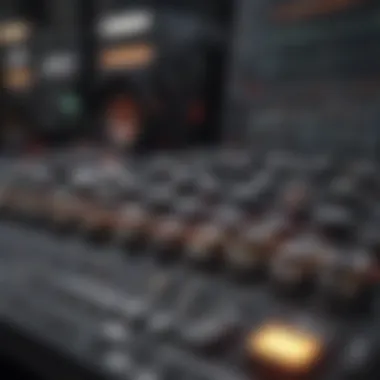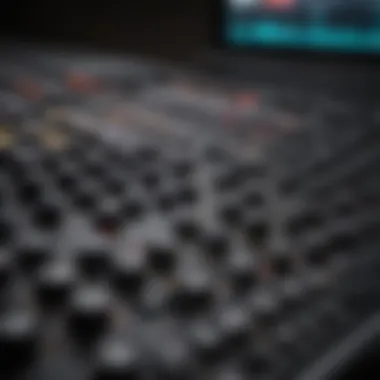Mastering Song Editing: Techniques and Tools


Intro
Editing songs can seem like a daunting task, especially when you’re just starting out in music production. From sorting through countless takes to sculpting the final soundscape, the editing process is crucial in bringing your artistic vision to life. It involves an array of techniques, tools, and knowledge about various aspects of music. This article serves as a thorough roadmap to demystify the world of song editing.
Not only do we delve into software selection, but we also cover advanced editing strategies and the significance of musical structure. If you’re an eager learner or a budding producer, by sticking with this guide, you'll gather insights that can elevate your musical creations. Whether you’re polishing a track or crafting a hit, having solid editing skills is non-negotiable in today’s fast-paced music landscape.
Let’s start uncovering the essentials for editing songs effectively.
Prelims to Song Editing
Song editing is more than just cutting and pasting audio clips; it’s about sculpting a piece of sound that captures emotion and tells a story. The art of editing can elevate a track from something unremarkable to a polished gem that resonates deeply with listeners. Understanding the intricacies of this process can be a game changer for budding music producers, as it allows them to bring their creative visions to life.
When we look at song editing, the focus is on the nuances that turn raw material into a finished product. Every small tweak can shift the entire vibe of the music, and knowing how to use editing tools effectively is just as critical as having a good sense of melody or rhythm. A well-edited song can convey feelings, maintain energy, and keep the listener engaged from start to finish.
There are several key elements to consider in song editing:
- Structure and Flow: Understanding how different parts of a song fit together is essential. You want the transition from verse to chorus to be smooth, like a well-oiled machine.
- Audio Quality: The clarity of sound is paramount. Unedited tracks can sound muddled; hence, the need for proper editing techniques to enhance clarity and equilibrium.
- Creative Effects: It's all about the layers. Adding effects can provide depth and character to the track, opening doors to new possibilities.
Choosing to dive into song editing also involves understanding various nuances that come with it:
- The Balance of Creativity and Technique: Song editing isn’t just tech work; it’s a fine blend of art and mechanics. Knowing when to follow the rules and when to break them for creative purposes is part of honing one’s skills.
- Feedback Loop: Getting feedback is crucial in the editing process. What may sound good to one person may not resonate with another, and a fresh perspective can illuminate things you didn't notice before.
"Edit your song as if it's a canvas, each stroke represents a decision that leads to a masterpiece."
In sum, song editing is a critical skill that every music producer should master, as it enriches the finished product and enhances the auditory experience for the audience. Establishing the fundamental principles of song editing is a journey filled with exploration and experimentation, making it not just a task, but an engaging and creative adventure. As we navigate through this guide, we'll unravel the various aspects that contribute to effective song editing, ensuring that you come away with the skills and knowledge that can help you flourish in your music production endeavors.
Understanding the Basics of Song Editing
Grasping the fundamentals of song editing is essential for any budding music producer or enthusiastic hobbyist. It lays the groundwork for more advanced techniques, helping to create a seamless and polished final product. In essence, song editing transforms initial recordings into cohesive audio pieces, contributing to the overall feel and message of the music. By understanding what song editing entails, individuals can enhance their creative flow and make informed decisions that impact the listening experience.
The Role of Song Editing in Music Production
Song editing plays a pivotal role in the music production process. It’s not just about cutting and pasting audio clips; it’s about crafting a narrative that resonates with listeners. Proper editing enables producers to manipulate various elements of a track, ensuring that the final piece aligns with the artistic vision. A well-edited song can elevate a piece from mediocre to memorable by removing unwanted noise, highlighting key sections, and fine-tuning dynamics.
Editing also facilitates the blending of various musical elements into a singular, harmonious output. When tracks are played in unison, the nuances of timing and articulation become apparent. This requires keen attention to detail, to mix together different instruments and vocals in a way that complements the overarching sound. Therefore, an understanding of song editing is not merely beneficial; it’s a necessity for effective music production.
Common Terms and Concepts in Editing
In the realm of song editing, familiarizing oneself with essential terminology can provide valuable insights. Here are some key concepts to keep in mind:
- Waveform: The visual representation of sound. It illustrates the amplitude of audio signals over time, allowing producers to see where adjustments are needed.
- Timeline: A chronological arrangement of audio clips within an editing software. Understanding the timeline is crucial for organizing tracks and ensuring they align properly.
- Fade In/Fade Out: Techniques used to smoothly transition into and out of audio sections. This is important for setting the mood and ensuring that the music flows naturally.
- EQ (Equalization): This involves adjusting the frequency balance of audio. Proper EQ can make a track sound fuller or clearer, depending on the desired outcome.
Understanding these terms enhances communication among artists, producers, and sound engineers, leading to more efficient collaboration. It's analogous to learning the lingo of a new community—once you know the basics, you can dive deeper into the more complex aspects of music editing.
"Knowledge of editing terms can transform confusion into clarity, allowing for creative ideas to flourish more freely."
In summary, getting a firm grip on the basics of song editing is not only vital for improving production quality but is also a pathway to exploring the creative possibilities in music composition.
Choosing the Right Editing Software
Choosing the right editing software is a critical step that can significantly influence your song editing experience and the quality of your output. It is much more than just picking a tool; it’s about finding a platform that aligns with your style, needs, and workflows. The right software can help you unlock your creative potential, streamline your editing process, and provide powerful tools that can elevate your music to new heights.
Various factors come into play when selecting the ideal software. Whether you're a seasoned producer or a budding enthusiast, understanding what you need is key. Features like audio quality, ease of use, and compatibility with your existing hardware and instruments cannot be overlooked. The software should resonate well with your musical sensibilities, while also being robust enough to tackle more complex editing and mixing tasks as your skills develop.
In this section, we will delve into specific elements you should consider when choosing your editing software, the benefits that come with picking the right tool, and thoughtful considerations that can enhance your song editing journey.
Key Features to Look for in Editing Software


When it comes to choosing editing software, you need to have a solid checklist of features that are must-haves for effective song editing. Here’s what to look for:
- User-friendly Interface: The design and layout should be intuitive. You don't want to waste time grappling with complex menus.
- Multi-track Editing: This feature enables you to work with various audio tracks simultaneously—an essential when mixing instruments and vocals.
- Real-Time Effect Processing: The ability to add effects as you go can significantly enhance your creativity and workflow.
- Undo and Redo Functions: A crucial feature that lets you experiment without fear of making irreversible mistakes.
- File Compatibility: Ensure the software can support various audio file formats. You want flexibility when importing and exporting.
- Platform Support: Consider whether the software runs on your operating system, as well as the availability of mobile versions if you prefer working on the go.
- Collaboration Features: In today's music production landscape, being able to collaborate seamlessly with others is invaluable.
“Find software that not only meets your current needs but can also adapt as you grow as a producer.”
Choosing an editing software with these features paves the way for smoother workflows and better creative output. It can deeply affect your user experience, making each session enjoyable rather than frustrating.
Popular Software Options for Song Editing
With a plethora of options available, pinpointing the best software may feel overwhelming. Below are some of the popular choices among the music production community that align with various skill levels and requirements:
- Ableton Live: Known for its session view that’s great for live performances and improvisation; it’s widely favored by electronic music producers.
- Logic Pro X: A favorite for Mac users, it offers a comprehensive suite of features well-suited for both new and experienced producers.
- FL Studio: Renowned for its user-friendly interface, especially appealing for beginners, FL Studio makes beat-making an easy task.
- Pro Tools: Often referred to as the industry standard, this software is perfect for advanced users needing extensive audio editing capabilities.
- Cubase: A solid choice for comprehensive MIDI and audio editing, suitable for producers who work with both live instruments and electronic sounds.
Exploring forums like Reddit or consulting articles from Britannica can further guide your decision. Each software has its strengths and weaknesses, so take advantage of free trials where possible to find what feels best for your workflow.
Preparing Your Audio Files for Editing
Preparing your audio files is a crucial stepping stone in the song editing journey. It's like laying the groundwork for a house; you want a solid foundation before you start putting up walls and a roof. Proper preparation can save you a heap of trouble down the line.
When you take the time to get your audio files in order, you ensure a smoother editing experience. This not only impacts your workflow positively but also boosts the quality of your final product. The main goal here is to minimize confusion and streamline your creative process.
Importing and Organizing Audio Tracks
First things first: importing audio tracks into your editing software. Depending on the platform you're using, this part can vary a bit. Most programs have a straightforward drag-and-drop functionality, which is a breeze. But don’t just stop there; organization is key.
Think about how you want to structure your project. Maybe create folders for different instruments, vocals, and effects tracks. Using clear, descriptive names can make a world of difference. Instead of Session1, why not label tracks like "Guitar_Main" or "Vocals_Harmonies"? This practice can save you valuable time when you're deep into the editing process.
Don’t forget to check the initial placement of tracks; ensuring they line up correctly will prevent any timing issues later. Environmental noise or artifacts from recording must also be noted during this step. Combining track placements with logical naming conventions prepares you for an editing session that flows without a hitch.
Understanding File Formats and Quality
Another vital aspect of preparing your audio files is understanding file formats and their respective qualities. Different formats have various strengths and weaknesses. For instance, WAV files offer high fidelity due to being uncompressed; however, they do take up a lot of disk space. On the other hand, MP3 files save space but sacrifice quality. It’s a trade-off that you must consider based on your needs.
If your goal is to produce a professional-sounding track, working with uncompressed formats during editing is typically advisable. You can save space by converting to compressed formats only after the finalization process—when the sound is perfectly tweaked. This way, you ensure that all the nuances of your edits are retained.
Additionally, consider the sample rate and bit depth as they play a significant role in audio quality. For everyday music production, a sample rate of 44.1 kHz and a bit depth of 24-bit typically works well. But you can decide to go for higher specs depending on the complexity of your project.
It’s always best to start with the highest quality audio possible. This offers the most flexibility when editing and can greatly influence the final sound.
Taking the time to prepare your audio files appropriately pays off. Not only does it set you up for a more efficient editing experience, but it also gives your musical composition the best chance to shine.
Editing Techniques and Strategies
Editing a song is much like refining a diamond; it’s all about shaping, polishing, and ultimately bringing out the best in what you have. This section delves into techniques and strategies that enhance the overall quality of your song. Why is this so crucial? Because even the most talented musicians can benefit from meticulous editing work. A well-edited song can captivate listeners and ensure that every note resonates.
Cutting and Trimming Audio Sections
When you're in the thick of editing, cutting and trimming audio might seem as basic as pie. However, this process is more than just snipping away at the audio. It involves identifying the heart of each section and removing anything that distracts from that raw emotion. Often, less is more. Here’s why cutting and trimming effectively can transform your track:
- Streamlines Composition: Removing excess parts eliminates clutter, helping listeners focus on the core message. It sharpens the contrast between verses and choruses, giving each part its due weight.
- Builds Dynamism: A tightly edited song can create dynamic shifts that energize the listener. By cutting out unnecessary repeats or long pauses, you keep the momentum flowing.
- Enhances Catchiness: Listeners love a song that hooks them quickly. By trimming the fat, you can make sure your best parts come to the forefront sooner.
In practice, this can often mean using your editing software’s cutting tool to take out long pauses or sections that don’t contribute meaningfully. But remember, every cut should serve the song rather than just be an impulsive choice.
Adjusting Volume Levels and Balance
Ready to delve into mixing? Balancing levels in your song is akin to seasoning a dish. Just a bit too much salt can ruin the flavor, and likewise, an imbalanced track can leave a sour taste in the listener's ear. Adjusting volume levels ensures every element of your track is heard as intended. Here are some focal points to consider:


- Clarity of Instruments: Each instrument in your mix should shine without overpowering the others. For instance, if the vocals are too low compared to the guitars, it’ll take away from the lyrics’ impact.
- Dynamic Range: A good balance allows for the natural ebb and flow of loud and soft sections. This dynamic range keeps the listener engaged, making emotional peaks more pronounced.
- Creating Space: Using panning techniques to place instruments within the stereo field can give your tracks a sense of depth. For instance, placing guitars to the left while keeping the vocals centered sets a clear focus in the mix.
A detailed analysis of your track with reference to volume adjustments every so often is wise. Often, returning to the track after a brief break provides you with fresh ears, allowing you to better notice any discrepancies.
Using Effects and Plugins for Enhancement
The world of audio effects is like a painter’s palette. Each plugin and effect offers various colors to enhance your canvas. The right effects can make a track come alive, while the wrong ones can turn it into a muddy mess. Here’s how you can effectively use them:
- Reverb and Delay: These are foundational effects that create space and ambiance in a track. Reverb adds a sense of depth, making it sound as if the audio was recorded in a hall, while delay can create echo effects that add rhythm and texture.
- EQ (Equalization): This allows you to adjust the frequency balance in your audio. If a vocal sounds too nasally, reducing certain frequencies with an EQ plugin can help smooth things out, giving your mix clarity.
- Compression: This effect helps control the dynamics of your track. Applying a compressor can assist in smoothing out volume levels, ensuring that quieter parts can be heard without losing the excitement in louder sections.
"The art of music editing lies in the details – a well-placed cut, a slight reverb, or that perfect balance makes all the difference."
By mastering these editing techniques, you enhance and elevate your music, maybe even turning raw tracks into chart-toppers.
Refining the Musical Structure
When diving into the intricate world of song editing, one cannot overlook the significance of refining the musical structure. This stage involves shaping the composition into something that not only resonates with listeners but also tells a compelling story. The benefits of this process are far-reaching; a well-structured song captivates, retains attention, and ultimately, enhances artistic expression.
Identifying and Maintaining Song Flow
The flow of a song is akin to the rhythm of a conversation; it determines how information is paced and delivered. The listener should experience an effortless journey through the sections of the song. To achieve this, it is crucial to identify the natural transitions between verses, choruses, and bridges. Here are some practical strategies to maintain effective song flow:
- Establish Clear Sections: Each part of the song serves a purpose. Verse sets up a narrative, the chorus amplifies that message, and a bridge offers a refreshing twist. Mapping out these sections can clarify the overall structure.
- Use Dynamic Changes: Strategically place shifts in dynamics or tempo to guide listeners through emotional highs and lows. Such changes can prevent a song from feeling monotonous while enhancing engagement.
- Pay Attention to Lyric Rhythm: The way lyrics are paced and delivered impacts flow. A smooth, coherent lyrical structure mirrors good conversation, whereas jarring transitions can confuse listeners, pulling them out of the experience.
Keep in mind that the key is to strike a balance between predictability and surprise. Too much of either can derail the overall listening experience.
Transitions and Segue Techniques
Seamless transitions are the glue that holds the musical story together. A well-executed segue from one section to another can elevate a song, giving it the polish it deserves. Let's discuss some effective techniques for creating transitions and segues:
"A transition is not just a change; it's a careful weaving of sound, a dance between scenes."
- Fading In and Out: Gradually increasing or decreasing volume can cue the listener to expect a shift without being abrupt. Consider using crossfades to create a more fluid sonic experience.
- Using Effects and Sounds: Sounds like risers or reverse cymbals create anticipation for the next section. Similarly, using ambient sounds or effects can fill gaps between sections, ensuring a smoother flow.
- Rhythmic Syncopation: Altering the drum patterns or using a distinct percussion lead-in can signal a change while adding depth. For example, a quick drum fill can lead into a new verse or chorus effectively.
- Melodic Segues: Carry the motif or melody from one section into the next to create continuity. It reinforces themes and gives listeners something familiar as they journey through the song.
Overall, refining the musical structure is about precision and intent. Every choice made impacts the final product and reflects your artistic vision. With a keen ear for flow and seamless transitions, the editing process becomes a powerful tool for elevating any musical piece.
Mixing and Mastering Essentials
Mixing and mastering are pivotal phases in the song editing process that can make or break a track. These stages are not just about making everything sound decent; they are the art of bringing clarity and a professional edge to your music. Mixing ensures all elements in the song work in harmony, while mastering is the final polish, shaping the track for distribution. Each step offers its own challenges, but also countless opportunities for creativity.
Understanding Mixing Fundamentals
To put it simply, mixing is the process where different audio tracks within a song are blended together. It includes balancing levels, adding effects, and panning sounds to create depth and space. At this stage, it’s essential to listen critically to the balance between vocals, instruments, and any effects you may use. Here are some critical elements to consider during the mixing process:
- Levels: It’s often about finding that sweet spot for each element. You want your vocals to sit well with the instruments—neither should overpower the other. A common practice is using a fader to adjust volume levels until everything feels right.
- EQ (Equalization): This is a valuable tool for carving out space in the mix. It helps to boost or cut frequencies to ensure that different instruments and sounds don’t clash.
- Effects: Whether it’s reverb, delay, or compression, effects can greatly enhance the listening experience. But tread carefully, as too many effects can muddle the clarity.
- Panning: Think of your sonic landscape. You may want to place certain instruments to the left or right to create a more immersive feel.
Mixing requires not just technical know-how, but also a good ear. The trick is to take your time, step back, and hear how it comes together. Practice makes progress here, so don’t hesitate to experiment with different settings until you reach a sound that clicks.
Finalizing with Mastering Techniques
Once mixing is done, it’s time for mastering, the last piece of the puzzle. Many consider this to be a bit like the cherry on top of a cake—essential for making it look good and taste even better. Mastering ensures your track sounds consistent across all playback systems, from earbuds to high-end sound systems.
Some considerations in mastering include:
- Loudness: Achieving the right loudness can be tricky. You want your track to punch through without distortion. This often means setting the loudness to a commercial level, often around -14 LUFS for streaming.
- Consistency: All songs on an album should sound cohesive when played back-to-back. Mastering helps unify the sound of the entire collection.
- Final EQ Adjustments: Sometimes, tiny tweaks are necessary to avoid certain frequencies clashing after mixing.
- Dither: When bouncing down your final master, employing dither helps to minimize distortion when reducing bit depth, especially when going from 24-bit to 16-bit.
Mastering is not just about boosting volume; it's about enhancing the listening experience.
Ultimately, mixing and mastering are about more than just producing a good sound. They involve understanding the emotional intent behind the music and translating that into the final product. In this stage, you’re not only finalizing sounds but also crafting the listener's journey, ensuring that every note resonates and holds significance.


By grasping these principles, you empower yourself as a creator, opening doors to a more polished and professional body of work.
Reviewing and Revising Your Edits
In the intricate world of song editing, the phase of reviewing and revising your edits is nothing short of paramount. Many budding producers dive into the editing process but often overlook the need to take a step back and assess their work critically. This step is not just about fine-tuning; it’s about breathing life into your song. Every note, every beat, and every pause has a purpose, and making sure they align with your artistic vision can significantly elevate the final piece.
Taking the time to review allows you to identify any inconsistencies—those moments where the flow feels a bit off or where the transitions could use some polish. Revising is where you truly sculpt your sound, making decisions on adjustments that could lead to a more engaging listening experience.
Importance of Taking Breaks for Fresh Ears
When you're deep into editing, your perception can get a bit muddied. You’ve been so intimately involved with the track that your ears might start playing tricks on you. This is where the wisdom of taking breaks comes into play. It’s often said that stepping away can be as crucial as the editing itself. By allowing yourself some distance—whether that’s a few hours or even a full day—you give your auditory senses the time they need to rejuvenate.
After a break, when you return, the music sounds different. Those minor flaws that you’ve glazed over start to pop out. Not only that, but your brain is now more attuned to thinking critically. It can also help ward off the tunnel vision that comes from spending too long on a single project.
Gathering Feedback from Peers
No artist is an island, and this truth resonates loudly when it comes to editing songs. Seeking feedback from peers can provide a fresh perspective that you might not have considered. Friends, fellow musicians, or even trusted mentors can help unearth insights that can refine your track even further. They may catch a section that feels rushed or could suggest an alternate arrangement that enhances the song’s structure.
When asking for feedback, consider using specific questions to guide their responses. For instance:
- Does the song maintain a cohesive flow?
- Are there instrumental sections that overshadow the vocals?
- Is there an emotional connection elicited from listening?
Epilogue
In summary, revising and reviewing your edits serves as a powerful opportunity to polish your work to perfection. Incorporating breaks into your routine allows your ears to reset, while gathering feedback enriches the creative process. These steps not only enhance the quality of your song but also develop your skills as a savvy music producer. By taking these simple yet effective measures, you can be sure that your final piece resonates with your intended audience.
Exporting and Sharing Your Edited Song
Editing a song doesn’t just end when you put the last touch on it; that’s akin to painting a masterpiece but never showing it to the world. The process of exporting and sharing your music is vital, serving as the bridge between your creative endeavors and the audience that awaits your sound. It holds a world of importance, as it determines the final quality of the piece heard by listeners, sets your professional tone, and can even affect your overall reputation in the music scene.
Finding the right export settings involves understanding various factors that influence the final product. This is where the technical knowledge you’ve acquired through the editing process pays off. Each setting you choose, from file format to bitrate, impacts how your music gets perceived. A careless selection could lead to quality losses, obstructing all your hard work.
Choosing the Right Export Settings
When it’s time to send your newly edited song into the wild, put some thought into the export settings. Your ultimate goal is a track that not only sounds good but also translates well across various platforms and playback devices. Here are a few key aspects to consider:
- File Format: Different formats suit different purposes. For example, MP3 files are compressed and lighter, perfect for quick sharing or streaming. WAV files, on the other hand, retain higher audio quality, making them suitable for professional settings.
- Bitrate: This defines the audio quality. A higher bitrate results in better sound but at the cost of a larger file size. If you plan to distribute your music on platforms that prioritize quality, choosing a bitrate around 320 kbps for MP3 files or 24-bit for WAV is advisable.
- Sample Rate: Stick to common sample rates, like 44.1 kHz or 48 kHz. Staying within these parameters helps maintain compatibility with most playback devices.
- Mixdown Settings: If you have used multiple tracks and layers in your song, ensure that you’re mixing down properly before exporting. This is crucial to catch any discrepancies in audio levels or frequencies that can undermine your edit.
By mindfully selecting these settings, you ensure that your edited song retains its unique charm while maintaining professionalism.
Tips for Distributing Your Music Effectively
Distribution is the ticket to making sure your music actually gets heard. Think of it as sending your song off to get its first taste of the limelight. Here are some strategies to make that process smooth:
- Choose Distribution Platforms Wisely: Platforms like Spotify, SoundCloud, or Bandcamp each serve different purposes. Research which aligns best with your target audience. For instance, if your sound resonates with gamers, trying platforms that cater to that community could be beneficial.
- Promote on Social Media: Spread your edited track through social media channels. Engaging snippets can catch interest. Specially tailored posts for Facebook, Instagram, or even Reddit can allow your music to reach diverse audiences. A strong presence here fosters a fanbase.
- Utilize Email Lists: Build a mailing list from your personal website or past listening events. Personalized outreach can entice your followers to check out your latest work, generating interest right from the get-go.
- Networking: Connect with other musicians or producers. Collaborative projects or shares can lead to broader exposure. Joining dedicated online communities can foster partnerships and increase opportunities for your music to be shared across various channels.
In the end, the way you choose to export and share your music can either make or break your artistic journey. It’s all in the details, and a well-prepared strategy can elevate your song’s reach far beyond expectation.
Engaging with the right avenues in distributing your music propels you closer to the success you aim for. With each export setting refined and every sharing opportunity seized, you step into the limelight, ensuring that your hard work gets the appreciation it deserves.
Closure on Mastering the Art of Song Editing
As we approach the end of this guide, it’s crucial to reflect on the overarching importance of mastering song editing. This skill is not merely about cutting and arranging audio tracks; it’s an art form that merges creativity with technical know-how. The journey of editing a song can be seen as the sculpting of sound, taking raw materials and transforming them into polished masterpieces.
One of the most significant benefits of effective song editing is the ability to enhance the listening experience. Every decision made—whether it’s the timing of a guitar riff, the layering of vocals, or the nuanced adjustments to effects—plays a pivotal role in how the audience perceives the music. In this context, each choice is a brushstroke on the canvas of sound. It’s essential to consider not just how each element functions individually, but how they work together to create a cohesive whole.
Furthermore, the art of song editing empowers musicians and producers to tell a story through sound. Whether it’s evoking emotions or transporting listeners to different places, well-edited tracks can breathe life into a narrative. This storytelling aspect is often overlooked yet is fundamental to connecting with audiences, thus elevating the listening experience beyond mere entertainment.
However, aspiring editors should keep certain considerations in mind. Firstly, patience and practice are key. Navigating through audio editing software can feel overwhelming at times, but familiarity breeds confidence. Taking time to explore various techniques can lead to unique personal styles.
Moreover, the importance of constructive feedback cannot be overstated. Sharing drafts with trusted peers can offer fresh perspectives and insights.
"Great music evokes emotion, but great editing empowers that emotion to resonate."







